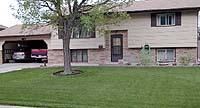RENEGADE GARDENER™
The lone voice of horticultural reason
Creating a Low Maintenance Lawn
About the only thing I remember from the seemingly endless Lawn and Turf Management course I took at the University of Minnesota was how warm the room was. The instructor was teaching all of us aspiring Master Gardeners how to grow and maintain a perfect lawn, and if not for the female bartender from Owatonna in the fourth row I do believe I would today be mad.
 But my head did jerk front, center and to the instructor when he begrudgingly swung into a brief dissertation on low-input lawn care. This practice is designed to minimize the amount of chemicals and, even more important, time and energy required by homeowners possessing the chthonic will to cast their lot with the Green Plague.
But my head did jerk front, center and to the instructor when he begrudgingly swung into a brief dissertation on low-input lawn care. This practice is designed to minimize the amount of chemicals and, even more important, time and energy required by homeowners possessing the chthonic will to cast their lot with the Green Plague.
It involves conversion – from the high energy, high input, greedy, demanding, scurrilous, petulant crop of Kentucky Blue grass we inherit when we purchase a home, to new, ultra low maintenance grass mixes. You don’t pull out the sprinkler during dry periods (at least I don’t), you never fertilize, the stuff doesn’t grow very fast, yet your lawn stays green and weed-free enough that your neighbors don’t report you to the local authorities. That’s right, there is an alternative for those who, like me, consider caring for a lawn the gardening equivalent to cleaning the toilet.
The University of Minnesota is a leader in study of low input lawn care (they’ve dubbed the topic “LILaC,” for Low Input Lawn … well, you get it), and has just released an update on the topic, including some new information and findings.
To quote my buddy, the sweet and saucy Deb Brown, U of M Extension Horticulturist, from her paper, “Several new low maintenance lawn mixes were planted, then monitored for three years in research plots at the Minnesota Landscape Arboretum and at the Waseca branch of the University’s Agricultural Experiment Station. While no one would mistake the results for a highly maintained golf course or finely manicured lawn, some were considered ‘acceptable’ by the crew of Extension personnel and Master Gardeners who evaluated them monthly throughout each growing season.”
Deb probably couldn’t resist placing parentheses around the word acceptable, since she understands the Turf Nuts at the University were simply damning with faint praise. (You have to realize, these guys have devoted their lives to studying GRASS.) I think she’d agree the correct way to read this is that it’s GREAT NEWS for any homeowner interested in seeing the pursuit of creating and caring for The American Lawn relegated into the same job bin that houses cleaning the gutters, shoveling the walk, and staining the deck.
Interested? I’ve been practicing LILaC for years, and my lawn typically looks cleaner and remains greener than the high-priced spreads on my block. Here’s a link to Deb’s paper on the University’s Extension Services Web site, plus a list of nurseries that can get you started with seed: http://www.extension.umn.edu/projects/yardandgarden/ygbriefs/h325lawn-lowmaint.html
Seed sources for low maintenance lawn mixes
Prairie Nursery
P.O. Box 306
Westfield, WI 53964
www.prairienursery.com
What’s in it: six different fescues. (Best to use this one if your neighbors are persnickety)
Dryland Ecology Lawn Mix
Nichols Garden Nursery
1190 North Pacific Highway
Albany, OR 97321-4580
www.nicholsgardennursery.com
What’s in it: perennial ryegrass and fine fescue with some flowers and clover
Fleur de Lawn
Hobbs and Hopkins, Ltd.
1712 SE Ankeny
Portland, OR 97214
What’s in it: mostly perennial ryegrass with some flowers and clover
Don Engebretson
The Renegade Gardener